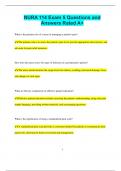NURA 114 Exam 5 Questions and
Answers Rated A+
What is the primary role of a nurse in managing a patient's pain?
✔✔The primary role is to assess the patient's pain level, provide appropriate interventions, and
advocate for pain relief measures.
How does the nurse assess for signs of infection in a postoperative patient?
✔✔The nurse should monitor the surgical site for redness, swelling, increased drainage, fever,
and changes in vital signs.
What are the key components of effective patient education?
✔✔Effective patient education includes assessing the patient's understanding, using clear and
simple language, providing written materials, and encouraging questions.
What is the significance of using a standardized pain scale?
✔✔A standardized pain scale provides a consistent method for patients to communicate their
pain levels, allowing for better assessment and management.
1
,How should a nurse respond to a patient expressing anxiety about a medical procedure?
✔✔The nurse should provide reassurance, offer information about the procedure, and encourage
the patient to express their concerns.
What are the typical signs and symptoms of dehydration in an elderly patient?
✔✔Signs of dehydration in an elderly patient include dry mucous membranes, decreased skin
turgor, confusion, and concentrated urine.
What strategies can a nurse implement to promote mobility in hospitalized patients?
✔✔Strategies include encouraging regular movement, using assistive devices, providing
physical therapy referrals, and setting mobility goals.
How does the nurse evaluate a patient's understanding of discharge instructions?
✔✔The nurse can evaluate understanding by asking the patient to explain the instructions in their
own words and by asking specific follow-up questions.
What is the importance of maintaining patient confidentiality in healthcare?
✔✔Maintaining patient confidentiality is crucial for building trust, complying with legal and
ethical standards, and protecting patient privacy.
2
,How can a nurse effectively manage a patient's nausea after surgery?
✔✔The nurse can manage postoperative nausea by administering prescribed antiemetics,
providing a calm environment, and offering clear, bland liquids as tolerated.
What are common complications to monitor for in a patient receiving anticoagulant therapy?
✔✔Common complications include bleeding, bruising, and signs of thrombosis such as swelling
or pain in the extremities.
What is the nurse's role in promoting a culture of safety in the healthcare environment?
✔✔The nurse's role includes reporting incidents, participating in safety drills, adhering to
protocols, and advocating for patient safety measures.
How should a nurse handle a medication error that has occurred?
✔✔The nurse should assess the patient’s condition, notify the healthcare provider, document the
error, and follow institutional policies for reporting.
What are the key factors to consider when developing a care plan for a patient with diabetes?
3
, ✔✔Key factors include the patient's blood glucose levels, dietary needs, medication adherence,
and the patient's understanding of their condition.
What techniques can be used to improve communication with patients who have hearing
impairments?
✔✔Techniques include speaking clearly, facing the patient directly, using written materials, and
utilizing sign language interpreters when necessary.
How can a nurse assess for signs of mental health issues in patients?
✔✔The nurse can assess mental health by observing the patient's behavior, mood,
communication patterns, and by conducting a mental status examination.
What strategies should a nurse implement to support a patient experiencing grief?
✔✔Strategies include providing a listening ear, offering support resources, allowing the patient
to express emotions, and validating their feelings.
What is the impact of cultural competence in nursing practice?
✔✔Cultural competence enhances patient care by improving communication, building trust, and
ensuring that care is respectful of and tailored to diverse backgrounds.
4




